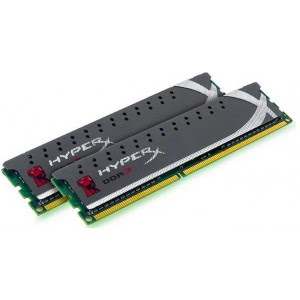Speedy memory without getting your hands dirty
The new Kingston HyperX Plug N Play Performance Memory really is the perfect memory match for Intel's Sandy Bridge chipset.
This chipset and its accompanying processors have brought a raft of goodies, particularly memory modules, claiming to be the perfect match for Intel's technology. In actual fact, though, the vast majority will pretty much work with any modern motherboard.
Now there is something else to add to the pile, but in the case of Kingston's new HyperX PnP modules, they actually do have something that needs the Sandy Bridge technology to bring the best out of them.
So what's so special about the new HyperX Plug N Play DDR3 memory modules? The Plug N Play bit. Surely that's what all memory is? Well, yes, up to a point, but these modules automatically run at the top speeds without having to enter the murky world of the BIOS. So no messing around changing settings to make sure it's running at the fastest speed.
Although tinkering about with the frequency and memory timings is second nature to overclockers and enthusiasts, the vast majority of people never venture anywhere near the BIOS, let alone change anything. And it's these people that Kingston is aiming the new modules at.
While you can use many different DDR3 memory speeds in conjunction with Intel's Sandy Bridge technology from 1.066MHz upwards, when it was launched Intel only mentioned L066/1.333MHZ support on any official specifications. This was because at the time these were the only officially supported speeds from J EDEC (Joint Electron Devices Engineering Council), the organisation that looks after the standards for memory. However JEDEC recently announced official support for both 1,600MHz and 1,866MHz.
Higher speeds
By programming the SPD of its new HyperX PnP modules with these new official JEDEC compliant settings. Kingston has memory that runs automatically at the higher speeds in Sandy Bridge mobos and notebooks. In the case of the desktop modules this is just 1.600MHz while quite bizarrely the laptop user gets the choice of either 1,600MHz or 1.866MHz modules. This review covers the desktop 4GB kit (KHX1600C9D3PIK2/4G) but there is an 8GB kit available too (KHX1600C9D3PIK2/8G). which is priced at £80.
So does it work? In a word, yes. We chucked the modules in a P67 equipped motherboard, fired it up and CPU-Z reported the memory running along nicely at 1,600MHz without us having to go anywhere near the BIOS. To aid the memory running smoothly, without resorting to adjusting settings in the BIOS. Kingston has used fairly conservative latency settings (9-9-9-27) with the HyperX PnP.
This stance means that as it stands these DDR3 modules run slower than the other 1.600MHz modules we tested it against. But this isn't about absolute performance memory prowess, this is about hitting rated speeds without the average PC gamer getting their hands dirty in the confusing world of the BIOS. And in that it excels.
By Simon Crisp


Conversion Conversion Emoticon Emoticon